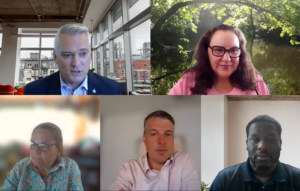ASDWA and GWPC Host Northeast States Source Water Protection Meeting with NRCS and EPA
 On July 12, ASDWA and GWPC hosted a virtual Northeast Source Water Protection Meeting with State Source Water Protection Coordinators, NRCS Regional and State Conservationists, and EPA Headquarters and Regions in the NRCS Northeast Region. Approximately 78 people attended the meeting that included representatives from all 14 states. The goal of the meeting was to connect NRCS and source water partners to each other and to mutual priorities and projects.
On July 12, ASDWA and GWPC hosted a virtual Northeast Source Water Protection Meeting with State Source Water Protection Coordinators, NRCS Regional and State Conservationists, and EPA Headquarters and Regions in the NRCS Northeast Region. Approximately 78 people attended the meeting that included representatives from all 14 states. The goal of the meeting was to connect NRCS and source water partners to each other and to mutual priorities and projects.
Karen Woodrich, the Acting Northeast NRCS Regional Conservationist, opened the meeting by sharing how partners can continue to work together to advance NRCS conservation priorities, funding, and projects to address natural resource concerns and protect drinking water sources. Moderators from EPA Regions 1 and 3 and speakers from the state source water protection and NRCS programs in Connecticut, Vermont, and Pennsylvania also provided information about their efforts to work together. These efforts included sharing data to create GIS maps to identify priority land parcels and implementation practices in source water areas; developing protection plans and watershed plans to ensure access to NRCS program funding for projects with water utilities, landowners, and other partners; and achieving mutual source water protection and water quality benefits and NRCS funding goals for critical conservation areas such as the Chesapeake Bay and Great Lakes.
During the discussion, participants talked about opportunities to engage in the NRCS 5-year strategic planning process and State Technical Committee meetings and help drive outreach and coordination with conservation districts, water utilities and other partners. Some of these opportunities included using state NRCS website maps and dashboards, as well as fact sheets and reports to share progress on implementation of source water protection funding. For more information about the meeting and opportunities to work with NRCS, view the agenda here, and visit ASDWA’s source water web page.

